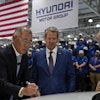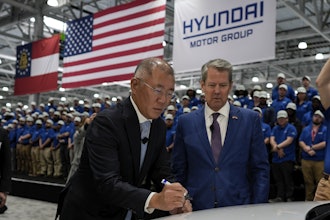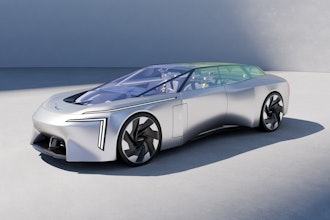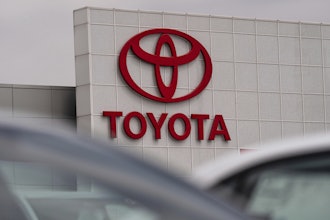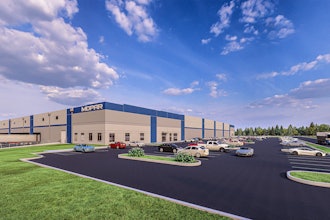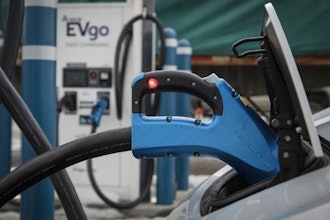DETROIT (AP) -- Buick's reputation as a premium American brand takes a new turn with the new-for-2011 Regal midsize sedan.
The five-passenger car that wears the well-known Regal name this year is nothing like the old Regals. Gone are the six-cylinder engines, the wallowy ride and the senior citizen styling.
The 2011 Regal -- the first Regal in U.S. showrooms since 2004 -- is attractive and modern, powered by four-cylinder engines, and it rides and handles with composure not traditionally expected of a Buick.
The early 2011 models aren't even built in . They come from a German factory, which has been building the sedans as Opel Insignias for Europeans for a couple years. Buick's parent company, General Motors Co., owns 's Opel.
But Buick pricing still is a bit on the premium side. Starting manufacturer's suggested retail price, including destination charge, for a 2011 Regal with 182-horsepower, direct-injection, four-cylinder engine is $26,995. A turbocharged, 2011 Regal with 258-horsepower four cylinder starts at $29,495.
Currently, both models come in CXL trim only, with many luxury features standard, including leather-trimmed seats, leather-wrapped steering wheel, Bluetooth connectivity, XM satellite radio, automatic dual-zone climate control and 18-inch wheels.
Standard safety items include front and side air bags, head curtain airbags, electronic stability control and traction control.
Pricewise, the Regal CXL models come in between the traditional sales leaders of the four-cylinder, midsize sedan segment, such as the Toyota Camry and Honda Accord, and the more luxuriously appointed, V-6-powered, midsize sedans, such as the Toyota Avalon and Lincoln MKZ.
For example, a decently appointed 2011 Camry SE with 169-horsepower, four-cylinder engine and automatic transmission starts at $24,250. Meantime, the starting retail price for a 2011 Lincoln MKZ with 263-horsepower V-6 is $35,180.
The test Regal with non-turbo engine and option package that added power adjustable front-passenger seat, sunroof, harmon kardon sound system and rear parking sensors, topped out at nearly $30,000.
I wouldn't have recognized this car as a Regal. It has a pleasing exterior appearance that's neither old-style nor weird. No one looked twice or asked about the test car. But at the rear of the car, styling reminded me of the old Pontiac G6.
Much of the engineering on the new, front-wheel drive Regal occurred at 's Opel, helping to explain why this Regal provides drivers and passengers with a sense of connectivity to the road. This wasn't a trait of many Regals of the past.
Steering in the test car had good, on-center feel, and I heard and felt mild vibrations as the tires went over manhole covers and other road imperfections. Yet, overall, the ride wasn't harsh or overly firm. The Regal tester was a car that would be easy for most any driver to turn on and just drive comfortably.
Drivers would be hard pressed to tell that there's only a four-cylinder under the hood. In the test car with naturally aspirated, 2.4-liter, double overhead cam, Ecotec four-cylinder, power came on steadily and with good "oomph."
Helping boost four-cylinder horsepower to 182, as opposed to the 169 horses in a four-cylinder Camry, is direct injection of the fuel. It's a feature that European carmakers such as Volkwagen AG have mastered to get the most power out of engines.
In the naturally aspirated Regal, peak torque is 172 foot-pounds at 4,900 rpm, and while it's not all there at slow speeds, there's enough that drivers don't have to feel like they're sitting ducks as they merge into traffic. Obviously, the pricier turbo Regal is more powerful, with 220 horses and 258 foot-pounds of torque at a low 2,000 rpm. Both engines are mated to six-speed automatic transmissions.
Neither version of Regal, though, is a fuel-sipper.
The best federal government fuel mileage rating for the 2011 Regal is 19 miles per gallon in city driving and 30 mpg on the highway for the non-turbo car, like the one I tested. This is nearly the same as the 20/30-mpg rating that the government gives to the V-6-powered Honda Accord midsize sedan with 271 horsepower.
In the test Regal, I managed just under 20 mpg during the test drive, which was nearly 70 percent city driving. Thus, with a gasoline tank capacity of 18.4 gallons, I could only go about 350 miles before needing a fillup of regular unleaded. Premium fuel is recommended for the turbo Regal.
The Regal's interior is a well-laid-out space that's quiet and devoid of most gimmicks. Seats provide good padding and support, particularly in the front, where the seat cushions are lengthy. But the leather had such a thick, durable feel, some passengers assumed it was good-looking vinyl.
The three-spoke steering wheel with built-in controls for the driver information center and radio adds a sporty touch.
Lighting and sizing of the gauges are done well, though the gasoline and temperature gauges are positioned strangely. When the gas gauge needle points downward, the car still has half a tank left. And when the temperature gauge needle points to the 3 o'clock position, the engine temperature is dangerously hot.
There's decent, 37.3 inches of legroom in the back seat, which is about the same as in the Honda Accord. Rear headroom suffers a bit because of the Regal's sloping roofline, but it's nice to see rear door windows that go down all the way. Trunk space measures a competitive 14.25 cubic feet.
The Regal line will be changing in coming months. Regal production will shift to a GM factory in , early next year.
And CX trim level models with less standard equipment are planned for the 2012 model year.


